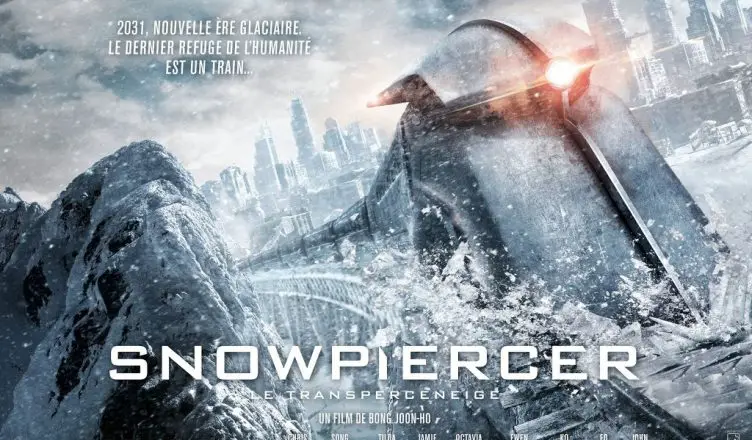Snowpiercer (Mori lieche)
Director: Bong Joon-ho
Writer(s): Bong Joon-ho, Kelly Masterson
Country: South Korea, USA
Year: 2014
Lord saw how great the wickedness of the human race had become on the earth, and that every inclination of the thoughts of the human heart was only evil all the time. 6 The Lord regretted that he had made human beings on the earth, and his heart was deeply troubled. 7 So the Lord said, “I will wipe from the face of the earth the human race I have created—and with them the animals, the birds and the creatures that move along the ground—for I regret that I have made them.” But Noah found favor in the eyes of the Lord. Genesis 5:32-10:1 New International Version (NIV)
Our cultural imagination, especially in Judeo-Christian tradition, for centuries had been preoccupied with the End of the World, the Great Flood, Apocalypse, the Armageddon, the Second Coming. In the last century we as a species have gathered enough technological power to end the world ourselves, without the need for an external power or theological determinism. Now our post-apocalyptic fiction is full of various scenarios on how it could happen. “The Matrix”, “Zombieland”, and “WALL-E” all represent different ways to an epic collapse of society. Even more than the actual causes of self-imposed apocalypses, these stories are interested in how leftovers of humanity would live and interact with each other. The usual answer – not very humanely. (Side note: if you have not seen the movie, this review might seem hard to follow. But if you’re determined – follow along)
A train is moving through frozen landscape carrying the leftovers of humanity, like a high-tech Noah’s Ark. Instead of the Flood we have the second Ice Age and instead of the “god” – an eccentric inventor Wilford (Ed Harris).
The engine is sacred and Wilford is divine.
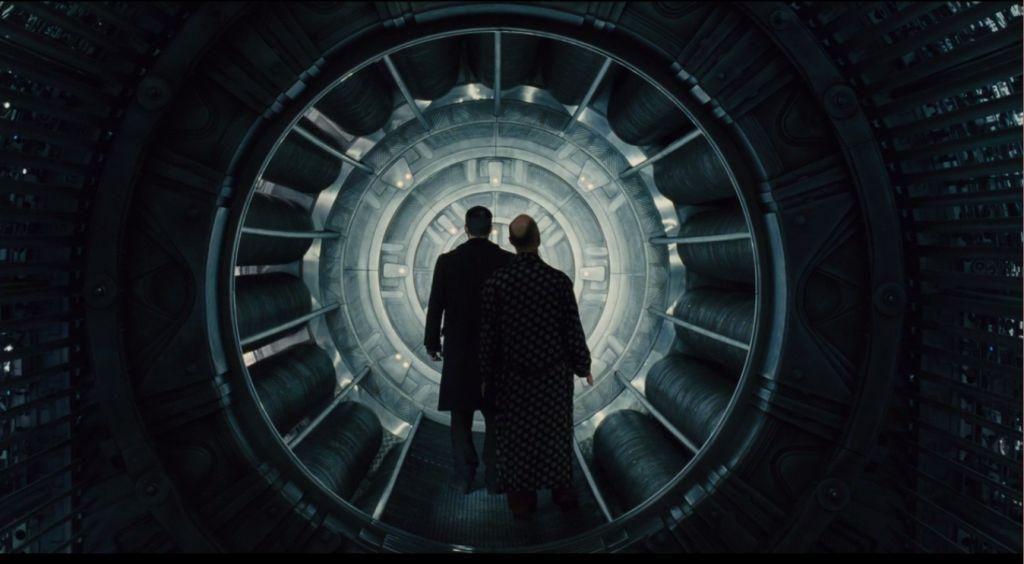
However, the reality of the train is far from Gardens of Eden. The shape of the train provides the basis for the class structure within it. At the tail section of the train we have the classless people. They are the ones who never bought the ticket to the train and were let in out of mercy. The further up the train, the better the conditions are until you get to the Engine. Thus other than post-apocalyptic fantasy, “Snowpiercer” is a story about a man’s search for meaning. Our Man is Curtis (Chris Evans, the Captain America in rags). He sets out to see the Father figure – Wilford, the savior, to ask him the purpose of the injustice and suffering in the world that he has created. If some live in paradise, why do others have to suffer in hell.
During his advancement towards the Engine, he meets a few impressionable characters. One of most striking ones is Wilfords minion Mason (Tilda Swinton in a brilliant performance). She gives her version to the answer Curtis is seeking, which reminds us of Marxists class struggle, or the traditional Indian cast system:
Order is the barrier that holds back the flood of death. We must all of us on this train of life remain in our allotted station. We must each of us occupy our preordained particular position. Would you wear a shoe on your head? Of course you wouldn’t wear a shoe on your head. A shoe doesn’t belong on your head. A shoe belongs on your foot. A hat belongs on your head. I am a hat. You are a shoe. I belong on the head. You belong on the foot. Yes? So it is. In the beginning, order was proscribed by your ticket: First Class, Economy, and freeloaders like you. Eternal order is prescribed by the sacred engine: all things flow from the sacred engine, all things in their place, all passengers in their section, all water flowing. all heat rising, pays homage to the sacred engine, in its own particular preordained position. So it is. Now, as in the beginning, I belong to the front. You belong to the tail. When the foot seeks the place of the head, the sacred line is crossed. Know your place. Keep your place. Be a shoe.
However, the Man is not satisfied with this version and he moves forward with help of his friends. Among those is Namgoong Minsoo, a Korean engineer, who created the locks of the train, and a psychedelic drug addict. He is played Kang-ho Song, who appears in other Bong Joon-ho’s films. He and his daughter Yona provide some comical relief and English-Korean misunderstandings that probably refer to actual difficulties that arose on a multi-national film set.
One of most memorable scenes vividly glorifying the class struggle and human revolt against authority was undoubtedly the torch carrying scene. It is uses the opportunity to show the strength in unity and revives the Ancient Greek myth of Prometheus, a Titan helping humanity against the will of gods. As director explained this scene himself:
in Korea they say:
One small flame can burn a whole field.” I was trying to express that cinematically. (…)I wanted that primitive, almost tribal aspect of the torch, running with a torch. (Source: Film Comment)
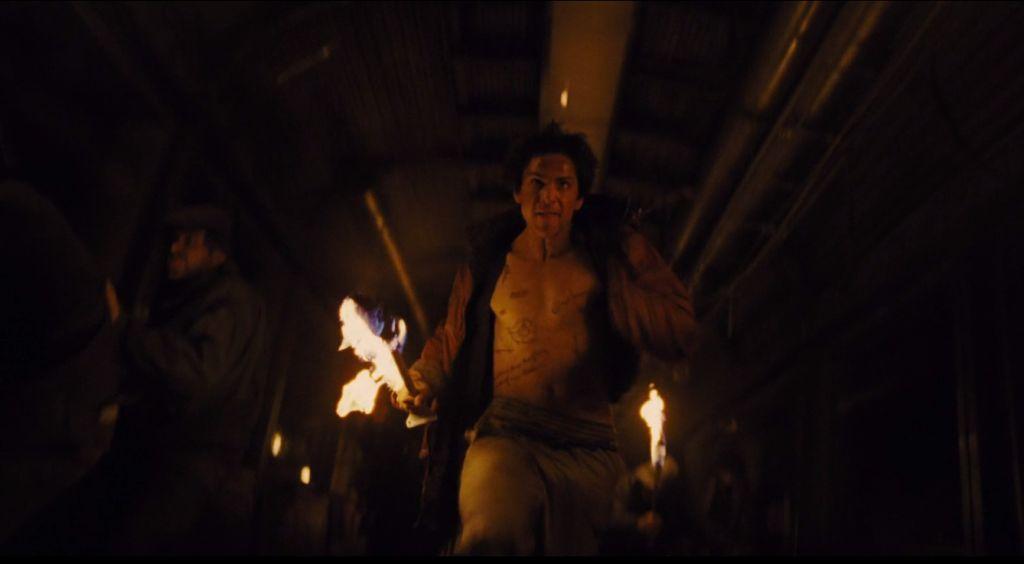
After that we get into a very contrasting school scene that looks like taken from obscure Disney children show. Here we have very unambiguous poking at an education system as a factory producing devotees of the system. Something like the iconic imagery from Pink Floyd “Another Brick in the Wall“, just in pink color, or from ironical G.O.A.T. exam in post-nuclear video game “Fallout 3”.
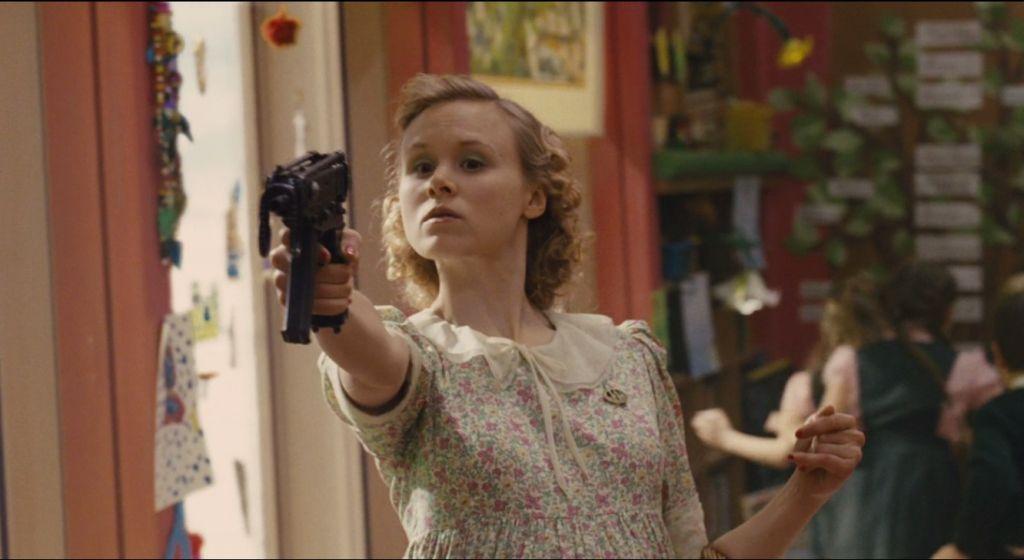
Curtis single-mindedly moves forward. This journey, however, does not come without difficult moral choices and losing comrades. These “moral decision” scenes are not given to us by dialogue, but through brilliant filming technique that takes the horizontal aspect of the train and plays with it. Tony Zhou in “Every Frame a Painting” explains it in detail:
As the viewer moves with Curtis, we see that the supposed paradise at the front of the train is not what was promised. While there are many luxuries, people do not seem to be happy. They are isolated and consumed with what they are doing, not reacting to anything that is happening around them. But Curtis is blind to this as he swifts through towards the Engine and the Father. Actually Curtis already has a father figure in the back of the train, a crippled man named Gilliam (John Hurt). In one scene he reveals a touching story about how Gilliam got crippled and we get a better look into the characters. One thing Gilliam advised Curtis at the start of the quest was “Do not let Wilford talk”. But being a prodigal son he does not listen to the advice and thus enters the temptation.
Again, the devil took him to a very high mountain and showed him all the kingdoms of the world and their splendor. 9 “All this I will give you,” he said, “if you will bow down and worship me.” Matthew 4:1-11 New International Version (NIV)
Wilford answers the question Curtis came to him with. The reason for the suffering is keeping the balance. Only the meticulously engineered balance of the train, the food rations, the water, births and deaths, can ensure the further existence of humanity. Moreover, Curtis is here to take over the duties of the Father in the sacred Engine room. For the first time we see a spark of doubt in the eyes of the man. He stormed through the train with relentless zeal and now his strong belief in humanity falters.
Ridiculous, pathetic, aren’t they? You can save them from themselves. Wilford whispers.
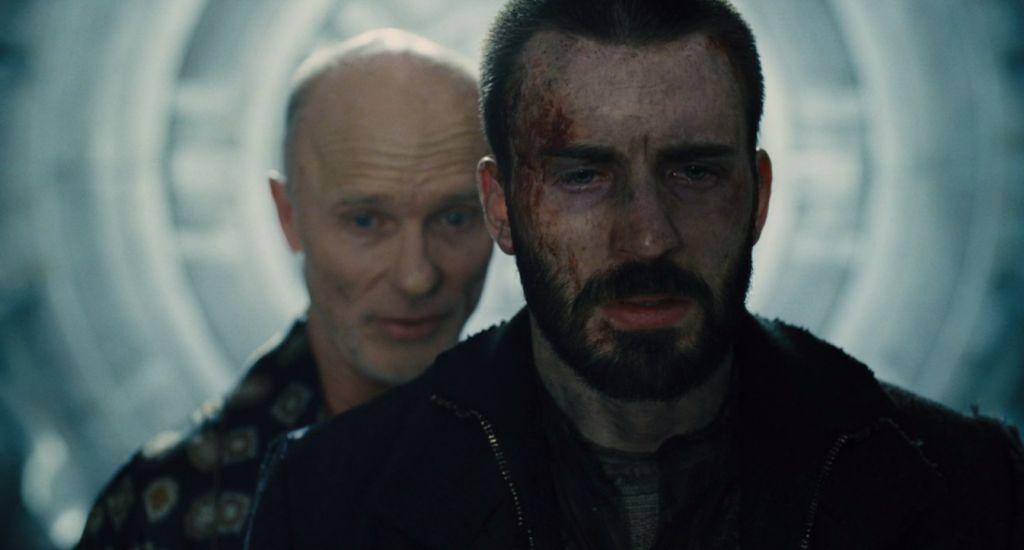
Curtis almost believes in the divinity of Wilford and the Engine. It takes an unspoiled perspective of a young girl, the engineer’s daughter Yona, to shatter the Wilfords image and break Curtis from the spell. She shows that Engine is actually not perfect and not Eternal, thus it is made by a man, not a god. Then with the use of fire they destroy the Engine.
The Lord smelled the pleasing aroma and said in his heart: “Never again will I curse the ground because of humans, even though[ i] every inclination of the human heart is evil from childhood. And never again will I destroy all living creatures, as I have done.
22 “As long as the earth endures,
seedtime and harvest,
cold and heat,
summer and winter,
day and night
will never cease.”Genesis 5:32-10:1 New International Version (NIV)
The end of the film or The New Beginning scene is very iconic. Only two children, who were born on the train and never saw the old world, survive. Like young Adam and Eve they step into the snow, first time moving diagonally away from train wreck, they raise their eyes onto vast nature. What was declared as Hell by the train authorities (as a matter of fact, in Dante’s Inferno Satan is trapped in ice), was actually the original place for life and human beings.
“Snowpiercer” gibes at humanities reliance on technology to save ourselves. The train when shown from inside seemed majestic, people were involved in their affairs and their missions appeared so important to them. In the end, however, train collapses and is shown as a small child’s toy in the grandness of nature. In nature there is no “preordained position” and no need to retain the balance, as nature balances itself. This is where the director draws our eyes to and “So it is”.
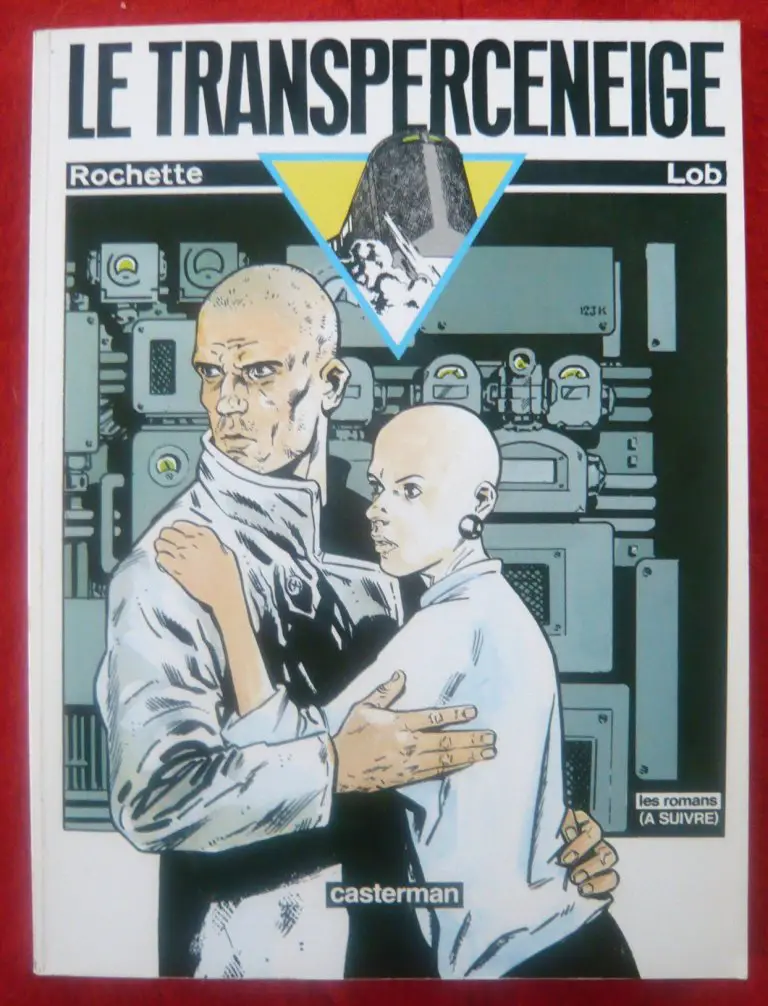
The film is inspired by French graphic novel series Le Transperceneige by Jacques Lob. Thus the story is rooted more in the mythology of the West. The Korean director gives a different flavor to it. There are some Bong Joon-ho’s staple absurd scenes, like Curtis slipping on a fish, or the same whole scene with axe fights and these esoteric warriors that look like taken from a BDSM scene (I mean really, what was up with that?). The director explains:
These moments are what make filmmaking fun and interesting. It wasn’t actually in the script, but when I was making the storyboards, I thought of this idea I mentioned before—a primitive aspect, like tribes in Africa, a ritual before battle to intimidate their enemies. Putting blood on their faces and whatnot. So I came up with this idea of the fish, but I also wanted to bring it back somehow, because it was such a cool concept. We decided to have Chris slip on it. It’s a bit of a strange moment but very natural for me, and Chris took to it immediately. He sort of laughed and said: “We’re doing all this cool action—you want me to slip on a fish? Why not?” We shot it very quickly. (…)While making the film, I don’t worry about whether people will get it. But being Korean and living in Korea, it’s a unique society. There’s an expression that describes the Korean mentality: not everything is logical, or not everything makes sense on the surface, but if you look carefully you can get an idea of what’s there. It’s hard to express but this is a very Korean thing. (Source: Film Comment)
These quirky scenes do make this film take itself less serious and a lot of fun to watch. It is a brilliant mash-up of things where East meets West.
And for a finishing touch, another brilliant The End of the World imagination by Douglas Adams – a more British perspective. Let’s hope that if Earth does get destroyed it will materialize back into existence again…
Ford Prefect: Six pints of bitter and make it quick, as the world is about to end.
Bartender: Yes sir. Nice weather for it. You serious sir? You really think the world is about to end?
Ford Prefect: Yes, in just over three minutes and five seconds.
Bartender: Well is there anything that we can do?
Ford Prefect: No, nothing.
Bartender: I always thought we are supposed to lie down. Or put a bag over your head or something.
Ford Prefect: Yes, if you like.
Bartender: Would that help?
Ford Prefect: No, excuse me, I have got to go.
Bartender: Oh, well then. Last orders please.
- 24 Asian Movies and TV Shows to Watch on Netflix (Updated) - April 6, 2021
- Permission to Exist – a documentary on South Korea’s education system and mental health awareness among Korean teens - December 15, 2020
- Luang Prabang Film Festival Goes Online - November 2, 2020
